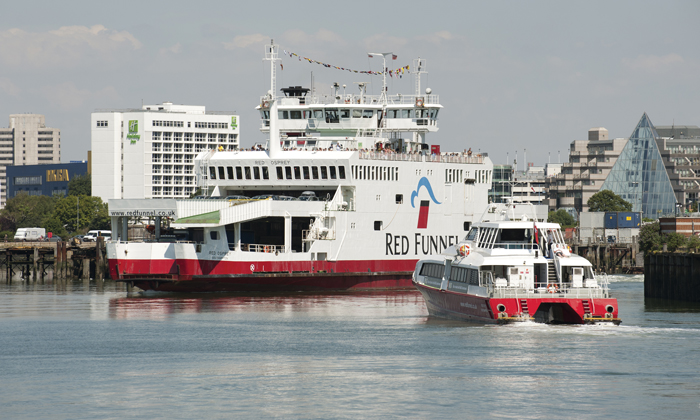How passenger information contributes to passenger satisfaction
- Like
- Digg
- Del
- Tumblr
- VKontakte
- Buffer
- Love This
- Odnoklassniki
- Meneame
- Blogger
- Amazon
- Yahoo Mail
- Gmail
- AOL
- Newsvine
- HackerNews
- Evernote
- MySpace
- Mail.ru
- Viadeo
- Line
- Comments
- Yummly
- SMS
- Viber
- Telegram
- Subscribe
- Skype
- Facebook Messenger
- Kakao
- LiveJournal
- Yammer
- Edgar
- Fintel
- Mix
- Instapaper
- Copy Link
Posted: 20 August 2017 | Gary Umpleby - Hogia Transport Systems | No comments yet
Gary Umpleby, UK Business Advisor at Hogia Transport Systems Ltd, takes a look at passenger information systems and examines the latest advanced passenger information solutions deployed by Norfolk County Council and Red Funnel.


The demand for a more accurate and timely delivery of passenger information continues to grow across all modes of transport. As a population, we are under continued pressure from central and local governments – from an environmental and travel congestion point-of-view – to leave our car at home and better utilise public transport. However, this requires us to leave the security and control of our own mode of transport to enter into, in the case of many, the ‘unknown’ world of public transport.
To encourage us to take this step into the unknown, public transport needs to be as comfortable, secure and easy to navigate as climbing into and driving our own vehicle. The provision of timely and accurate passenger information across numerous multi-media information platforms is therefore key to encouraging us to make this modal-shift (not everyone has a smartphone and even those that do may not have 100 per cent (reliable data coverage).
The pressure on our modern-day business and private lives means that we want to travel reliably and seamlessly across multiple modes of public transport (if this is what we are now expected to do) with minimal delay. We also want to be fully informed of travel options before and during a journey, taking into account any existing or developing transport service disruption. In fact, if we are to be convinced, and if travel approaches such as Mobility-as-a-Service are to be successful, then we need to make public transport safer, easier, more comfortable, and more reliable than travelling by private car.
Passenger information systems
Meeting passenger needs for accurate information before, during, and after their journey is one of the biggest challenges facing public transport providers today.


Red Funnel’s labour intensive passenger information solution before deployment of the Passenger Information System often resulted in passengers receiving inconsistent messages
A passenger information system enables a transport provider or customer service staff to create and distribute information to passenengers regarding their services, as well as connections with other transport providers’ transport modes, including the consistent and timely distribution of service deviations and disruptions across numerous multi-media distribution channels.
A passenger information system enables both private transport providers and public transport authorities, such as Red Funnel and Norfolk County Council, to do the following:
- Quickly create deviation and disruption messages through predefined message templates
- Deliver timely travel information to all, regardless of target group, media type or language
- Provide one source of consistent passenger information for all output channels, such as electronic displays, journey planners, mobile phones, websites, email, SMS, Twitter, and Facebook
- Have full traceability of messages
A passenger information system enables a variety of message types to be published including:
- Cancelled or amended departures
- Cancelled or amended arrivals
- Alerts/warnings
- Advisory messages for specific services or specific destinations
- Change of vehicle or vessel
- Message reminders
- Connection information to other modes of transport.
Successful passenger information delivery at Red Funnel


A single customer contact centre operator can now send consistent service deviation and disruption messages, as well as other useful passenger information, across multiple multi-media channels
Following a discussion over a conference dinner, a passenger information solution was crafted to place Red Funnel, the Isle of Wight to Southampton ferry company, at the centre of the Solent’s passenger travel information provision.
Previously, several members of the customer contact team had to be involved in disseminating travel information and service disruption information across the range of passenger information channels employed (electronic displays at the terminals, Twitter, SMS, website and email). The result was often inconsistent messages that did not meet Red Funnel passenger communication guidelines, and for some channels the messages were being sent after the event (due to the time it takes to disseminate such messages with limited resources).
The now-deployed solution enables a single member of the customer contact team to deliver timely and consistent travel information regarding the ferry services and connecting bus services, via pre-defined templates, with a few clicks of the mouse.
The information now being relayed to passengers 24/7 has been well-received and has added to the high level of customer satisfaction that in turn has led to Red Funnel receiving several notable customer service excellence awards. They include awards from the UK Contact Centre Forum (UKCCF) London & South East for Social Media Customer Service Team of the Year 2015; Customer Experience Team of the Year 2015; Social Media Customer Service Team of the Year 2016; Support Team of the Year 2016; Technology Partnership of the Year 2016; as well as the Customer Contact Innovation Living the Brand Award – 2016, from The Forum – Excellence in Customer Operations.
Red Funnel is now building on this initial investment by integrating live rail information, with the aim of delivering – both on-board ferry and bus – highly integrated multi-modal passenger information advising passengers of secure connections to the next mode of travel, as well as service deviations and disruptions for the ferries and connecting modes of public transport.
Norfolk County Council delivers advanced passenger information
Norfolk County Council has been at the forefront of delivering advanced passenger information for some years. Ahead of the UK government’s Bus Services Act 2017, and despite recent severe cuts in staff numbers, has successfully delivered the next stage of implementation in the form of real-time service deviation and disruption information working in partnership with several of its forward-thinking bus operators.
Norfolk County Council has for some time provided its smaller bus operators that don’t have access to scheduling systems with a highly functional web-based facility through which they provide their service schedules. This has also enabled Norfolk County Council to offer its travelling public a much higher and accurate level of information – both on paper and electronically.
Norfolk County Council recognised at an early stage that providing paper timetables and waysides, together with real-time departure information at stops and the bus station, was only a part of the travel information picture required by public transport passengers. This year Norfolk County Council has launched a service deviation and disruption notification capability, enabling its bus operators as well as Norfolk County Council staff to post service deviation and disruption information in real-time via high quality displays at bus stops, the bus station, and the rail station. This same information platform also gives Norfolk County Council the option in the future to disseminate the same information consistently via other media channels including Twitter, email, and SMS.
Several of Norfolk County Council’s bus operators are utilising the capability to keep their passengers informed of bus service issues. The solution also enables Norfolk County Council staff to publish messages relating to more generalised public transport issues and other County Council matters.


Norfolk County Council’s ‘Public Transport Data Management System’ enables the Authority to manage its statutory passenger information requirements with minimal staff
What of the future?
The Red Funnel and Norfolk County Council passenger information systems provide a sound base upon which both can build an even more functional passenger information delivery solution for the future.
Through the tighter integration of data from multiple public transport modes and the development of clear and unambiguous display formats across multiple multi-media platforms, passengers can in the not-too-distant future expect to receive far richer real-time passenger information content when and where they need it.
Once this has been achieved, it could be argued that we will be a significant step closer to persuading people that public transport can be as reliable and flexible to use as the private car… perhaps even more reliable in the future. This is especially true when comparing the high quality public transport information letting passengers know about network delays and disruption and how to work around it, with the unknown delays and disruption caused on the road network by incidents and road works…
Biography


Related topics
Passenger Experience, Travel & Passenger Information
Issue
Issue 4 2017
Related cities
United Kingdom
Related organisations
Hogia Transport Systems
Related people
Gary Umpleby








